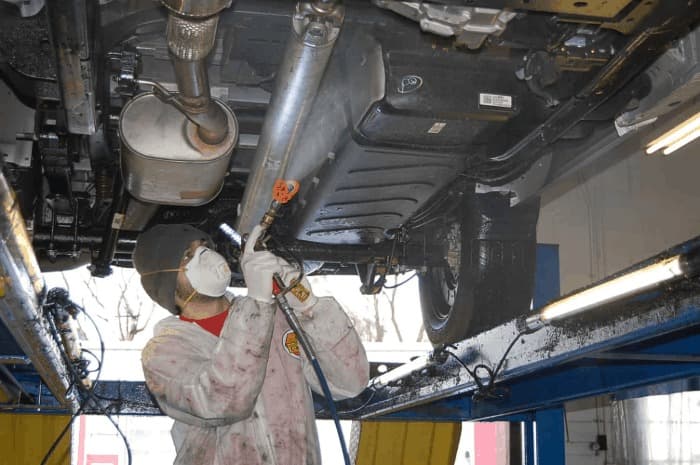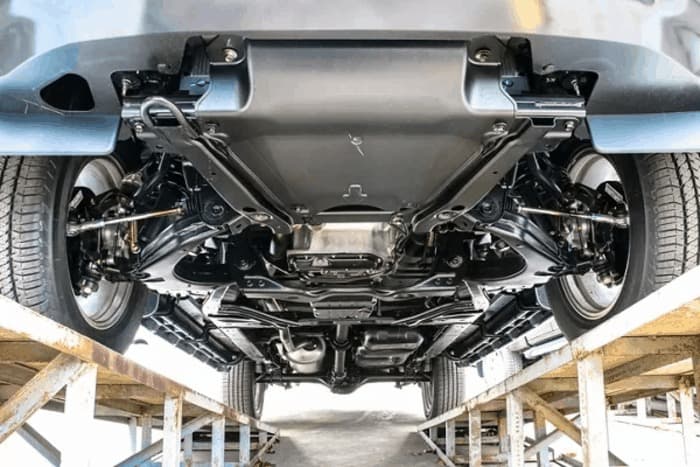Mosites Motorsports in North Huntingdon is one of the best places to have your car undercoated. But, did you know that you can do it yourself and save some money? In this blog post, we’ll show you how to undercoat your car in order to prevent rust and extend its lifespan. Keep reading to learn more!
- Why undercoating is important for your car
- What materials you need to undercoat your car
- How to prepare your car for undercoating
- The step-by-step process of undercoating your car
- How to maintain your car’s undercoating
- Conclusion
- Frequently Asked Questions
Why undercoating is important for your car
Undercoating your car is an important part of vehicle maintenance, as it creates a barrier between the exterior and interior of your car to protect vital components from corrosion. This process can also help reduce road noise, improve ride comfort, and prevent tire chain scraping noises.
Additionally, rustproofing helps coat panels and seams to reduce any damage caused by salt, water, or dirt. By doing so, you help preserve the resale value of your car since rust buildup can significantly reduce its worth. All in all, undercoating your car is paramount for it to remain reliable and well-researched for years to come.
What materials you need to undercoat your car
Painting your car requires the use of many materials to ensure a long-lasting, protective finish. One of the most important steps in painting is the undercoating process, which involves using a variety of materials unique to the task. Primer is an integral part of this process; it helps the paint adhere better by providing a clean, even surface and should be applied before any paint or top coats.
An undercoat sealant may also be used and acts as an additional layer of protection against corrosion and abrasion. Finally, an flex additive will also add extra life by increasing flexibility and durability when exposed to rough weather conditions. Completing these steps correctly will result in a professional painted finish that your car can wear proudly for years to come.
How to prepare your car for undercoating
Preparing your car for undercoating is a vital step in ensuring that it lasts as long as possible. To start, you should ensure that the area to which you are applying the protection coating is thoroughly cleaned and washed. Debris and leftover residue will interfere with how well the undercoat adheres to the body of your car. Additionally, any loose rust should be removed and any exposed metal should be sanded down before proceeding with undercoating.
After cleaning the car, you can use an etching system to create a more secure bond between the underside of your car and the coating itself. Finally, take care to make sure that no water enters through holes or ports on your car during application. Overall, investing in proper preparations for undercoating will guarantee a high-quality job that you can have confidence in.
The step-by-step process of undercoating your car

Undercoating your car is a great way to protect the bodywork and extend the life of your vehicle. Depending on the type of undercoating you apply, it can provide up to 10 years of rustproofing protection. To achieve this level of protection, it’s important to familiarize yourself with the process so you can do it correctly. The first step is to thoroughly clean your car from top-to-bottom, including the bottom side of any removable parts such as bumpers and hoods.
Next, inspect for any rust or existing undercoating that may need to be scrapped away. Once clean, sand off all painted surfaces and re-clean them with a wax and grease remover so that the undercoat adheres properly. Now you are ready for final preparation for application; use a spray or brush coat to finish it off and allow drying time prior to driving. Following these steps will ensure that your car stays rust free for much longer than usual!
How to maintain your car’s undercoating
Looking after your car’s undercoating is an important task; it protects the underlying metal from salt, road grime and other harmful elements. For best results, you should wash your car regularly with a mild detergent and cold water, as high temperatures can bake in dirt and lead to corrosion.
If your vehicle’s undercoating shows signs of wear, replenish it with an appropriate product that is designed to bond with the existing coating for maximum effect. Furthermore, consider rust-proofing the whole vehicle if necessary, especially in areas that tend to encounter more moisture than others. Don’t forget to wax the coat every few months to keep it in good condition throughout the year. Taking regular care of your car’s undercoating will help maintain its strength and integrity over time.
Conclusion
Now that you know all about undercoating your car, it’s time to get out there and do it! The process is simple and doesn’t take very long. Be sure to follow all the steps we outlined above, and don’t forget to maintain your car’s undercoating with regular cleaning and touch-ups. Do you have any questions about undercoating your car? Check out our FAQ section for more information.
FAQs about DIY car undercoating
What is undercoating?
Undercoating is a protective coating that is applied to the underside of a vehicle, such as cars, trucks, and SUVs. It helps protect the metal bodywork from rust and wear caused by road conditions, salt and other environmental factors that may otherwise cause corrosion.
What are the benefits of undercoating my car?
Undercoating your car is an excellent way to provide long-term protection against rust and corrosion, as well as keep it looking great for years to come. The benefits of undercoating a vehicle include improved longevity and appearance, better fuel efficiency, improved ride quality, and more.
Will undercoating protect my car from rust?
Yes, undercoating will protect your car from rust. The protective coating acts as a barrier between the metal bodywork and the elements that may cause corrosion or rust. This includes exposure to salt, moisture, and other environmental factors that can lead to rusting. By providing an extra layer of protection, undercoating can help prevent rust and extend the lifespan of your vehicle.
What kind of undercoating should I use?
The type of undercoating you should use depends on your car’s model and the conditions it will face. For salt air or high corrosion environments, epoxy-based undercoating is best. It generally consists of a two-part mixture that forms a tough coating that resists corrosion, as well as provides sound dampening.
For vehicles in less extreme climates and those with minimal rusting issues, wax-based undercoating are a good option.
How often should I undercoat my car?
Generally, it is recommended that cars are undercoated at least once every two years in order to maintain the best protection against rust and corrosion.


